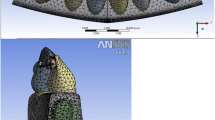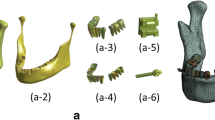Abstract
Objectives
This study aimed to compare the patterns of stress distribution in a lower second premolar using three conventional occlusal loadings and two more realistic loading scenarios based on occlusal contact areas.
Materials and methods
The teeth of a dried modern human skull were micro-CT scanned in maximum intercuspation contact with a Viscom X8060 NDT X-ray system. A kinematic analysis of the surface contacts between antagonistic right upper and lower teeth during the power stroke was carried out in the Occlusal Fingerprint Analyser (OFA) software. Stress distribution in the lower right second premolar was analysed using three-dimensional finite element (FE) methods, considering occlusal information taken from OFA results (cases 4–5). The output was compared to that obtained by loading the tooth with a single point force (cases 1–3).
Results
Results for cases 1–3 differ considerable from those of cases 4–5. The latter show that tensile stresses might be concentrated in grooves and fissures of the occlusal surface, in the marginal ridges, in the disto-lingual and in the distal side of the root. Moreover, the premolar experiences high tensile stresses in the buccal aspect of the crown, supporting the idea that abfraction might be a dominant factor in the aetiology of non-carious cervical lesions.
Conclusions
The application of FE methods in dental biomechanics can be advanced considering individual wear patterns.
Clinical relevance
More realistic occlusal loadings are of importance for both new developments in prosthetic dentistry and improvements of materials for tooth restoration, as well to address open questions about the worldwide spread problem of dental failure.



Similar content being viewed by others
References
Schwartz GT (2000) Taxonomic and functional aspects of the patterning of enamel thickness distribution in extant large-bodied hominoids. Am J Phys Anthropol 111:221–244
Spears IR, Crompton RH (1996) The mechanical significance of the occlusal geometry of great ape molars in food breakdown. J Hum Evol 31:517–535
Spears IR, Macho GA (1998) Biomechanical behaviour of modern human molars: implications for interpreting the fossil record. Am J Phys Anthropol 106:467–482
Macho GA, Spears IR (1999) Effects of loading on the biochemical behaviour of molars of Homo, Pan, and Pongo. Am J Phys Anthropol 109:211–227
Palamara D, Palamara JEA, Tyas MJ, Messer HH (2000) Strain patterns in cervical enamel of teeth subjected to occlusal loading. Dent Mater 16:412–419
Fernandes CP, Glantz P-OJ, Svensson SA, Bergmark A (2003) Reflection photoelasticity: a new method for studies of clinical mechanics in prosthetic dentistry. Dent Mater 19:106–117
De Jager N, de Kler M, van der Zel JM (2006) The influence of different core material on the FEA-determined stress distribution in dental crowns. Dent Mater 22:234–242
Jiang W, Bo H, YongChun G, LongXing N (2010) Stress distribution in molars restored with inlays or onlays with or without endodontic treatment: a three-dimensional finite element analysis. J Prosthet Dent 103:6–12
Cheng YY, Li JY, Fok SL, Cheung WL, Chow TW (2010) 3D FEA of high performance polyethylene fiber reinforced maxillary dentures. Dent Mater 26:211–219
Fu G, Deng F, Wang L, Ren A (2010) The three-dimension finite element analysis of stress in posterior tooth residual root restored with postcore crown. Dent Traumatol 26:64–69
Every RG (1972) A new terminology for mammalian teeth: founded on the phenomenon of thegosis. Parts 1 and 2. Pegasus, Christchurch
Kaidonis JA (2008) Tooth wear: the view of the anthropologist. Clin Oral Invest 12:21–26
Ichim I, Li Q, Loughran J, Swain MV, Kieser J (2007) Restoration of non-carious cervical lesions: part I. Modelling of restorative fracture. Dent Mater 23:1553–1561
Palamara JE, Palamara D, Messer HH, Tyas MJ (2006) Tooth morphology and characteristics of non-carious cervical lesions. J Dent 34:185–94
Khani MM, Tafazzoli-Shadpour M, Aghajani F, Naderi P (2009) Mechanical vulnerability of lower second premolar utilising visco-elastic dynamic stress analysis. Comput Methods Biomech Biomed Eng 12:553–61
Eraslan Ö, Eraslan O, Eskitaşcıoğlu G, Belli S (2011) Conservative restoration of severely damaged endodontically treated premolar teeth: a FEM study. Clin Oral Investig 15:403–408
Benazzi S, Kullmer O, Grosse IR, Weber GW (2011) Using occlusal wear information and finite element analysis to investigate stress distributions in human molars. J Anat 219:259–272
Benazzi S, Kullmer O, Grosse I, Weber G (2012) Brief communication: comparing loading scenarios in lower first molar supporting bone structure using 3D finite element analysis. Am J Phys Anthropol 147:128–134
Kullmer O, Benazzi S, Fiorenza L, Schulz D, Bacso S, Winzen O (2009) Occlusal Fingerprint Analysis (OFA)—quantification of tooth wear pattern. Am J Phys Anthropol 139:600–605
Kullmer O, Schulz D, Benazzi S (2012) An experimental approach to evaluate the correspondence between wear facet position and occlusal movements. Anat Rec 295:846–852
Palamara JEA, Palamara D, Messer HH (2002) Strains in the marginal ridge during occlusal loading. Aust Dent J 47:218–222
Rees JS (2002) The effect of variation in occlusal loading on the development of abfraction lesions: a finite element study. J Oral Rehabil 29:188–193
Hasegawa A, Shinya A, Nakasone Y, Lassila LV, Vallittu PK, Shinya A (2010) Development of 3D CAD/FEM analysis system for natural teeth and jaw bone constructed from X-ray CT images. Int J Biomater. doi:10.1155/2010/659802
Benazzi S, Kullmer O, Schulz D, Gruppioni G, Weber GW (2013) Individual tooth macrowear pattern guides the reconstruction of Sts 52 (Australopithecus africanus) dental arches. Am J Phys Anthropol 150:324–329
Kullmer O, Benazzi S, Schulz D, Gunz P, Kordos L, Begun DR (2013) Dental arch restoration using tooth macrowear patterns with application to Rudapithecus hungaricus, from the late Miocene of Rudabánya, Hungary. J Hum Evol 64(2):151–160
Benazzi S, Viola B, Kullmer O et al (2011) A reassessment of the Neanderthal teeth from Taddeo cave (southern Italy). J Hum Evol 61:377–387
Hattori Y, Satoh C, Kunieda T, Endoh R, Hisamatsu H, Watanabe M (2009) Bite forces and their resultants during forceful intercuspation clenching in humans. J Biomech 42:1533–1538
Li H, Zhou ZR (2002) Wear behavior of human teeth in dry and artificial saliva conditions. Wear 249:980–984
Magne P (2007) Efficient 3D finite element analysis of dental restorative procedures using micro-CT data. Dent Mater 23:539–48
Ko CC, Chu CS, Chung KH, Lee MC (1992) Effects of posts on dentin stress distribution in pulpless teeth. J Prosthet Dent 68:421–427
Rubin C, Krishnamurthy N, Capilouto E, Yi H (1983) Stress analysis of the human tooth using a three-dimensional finite element model. J Dent Res 62:82–86
Dejak B, Mlotkowski A, Romanowicz M (2007) Strength estimation of different designs of ceramic inlays and onlays in molars based on the Tsai-Wu failure criterion. J Prosthet Dent 98:89–100
Coelho PG, Silva NR, Thompson VP, Rekow D, Zhang G (2009) Effect of proximal wall height on all-ceramic crown core stress distribution: a finite element analysis study. Int J Prosthodont 22:78–86
Kondo T, Wakabayashi N (2009) Influence of molar support loss on stress and strain in premolar periodontium: a patient-specific FEM study. J Dent 37:541–548
Michael JA, Townsend GC, Greenwood LF, Kaidonis JA (2009) Abfraction: separating fact from fiction. Aust Dent J 54:2–8
Bartlett DW, Shah P (2006) A critical review of non-carious cervical (wear) lesions and the role of abfraction, erosion, and abrasion. J Dent Res 85:306–312
Telles D, Pegoraro LF, Pereira JC (2006) Incidence of noncarious cervical lesions and their relation to the presence of wear facets. J Esthet Restor Dent 18:178–183
Sneed WD (2011) Noncarious cervical lesions: why on the facial? A theory. J Esthet Restor Dent 23:197–200
Grippo JO, Simring M, Coleman TA (2012) Abfraction, abrasion, biocorrosion, and the enigma of noncarious cervical lesions: a 20-year perspective. J Esthet Restor Dent 24:10–23
Grippo JO (1991) Abfractions: a new classification of hard tissue lesions of teeth. J Esthet Dent 3:14–19
Geramy A, Sharafoddin F (2003) Abfraction: 3D analysis by means of the finite element method. Quintessence Int 34:526–533
Rees JS, Hammadeh M (2004) Undermining of enamel as a mechanism of abfraction lesion formation: a finite element study. Eur J Oral Sci 112:347–352
Perez Cdos R, Gonzalez MR, Prado NA, de Miranda MS, Macêdo Mde A, Fernandes BM (2012) Restoration of noncarious cervical lesions: when, why, and how. Int J Dent 2012:687058
Spears IR, van Noort R, Crompton RH, Cardew GE, Howard IC (1993) The effects of enamel anisotropy on the distribution of stress in a tooth. J Dent Res 72:1526–1531
Asmussen E, Peutzfeldt A, Sahafi A (2005) Finite element analysis of stresses in endodontically treated, dowel-restored teeth. J Prosthet Dent 94:321–329
Boschian Pest L, Guidotti S, Pietrabissa R, Gagliani M (2006) Stress distribution in a post-restored tooth using the three-dimensional finite element method. J Oral Rehabil 33:690–697
Pérez-González A, Iserte-Vilar JL, González-Lluch C (2011) Interpreting finite element results for brittle materials in endodontic restorations. Biomed Eng Online 10:44
Fill TS, Toogood RW, Major PW, Carey JP (2012) Analytically determined mechanical properties of, and models for the periodontal ligament: critical review of literature. J Biomech 45:9–16
Acknowledgments
We thank Martin Dockner from the Vienna Micro-CT Lab for assistance during scanning. The Occlusal Fingerprint Analyser software programming is financed by the ‘Deutsche Forschungsgemeinschaft’ (DFG, German Research Foundation). This is publication no. 53 of the DFG Research Unit 771 ‘Function and performance enhancement in the mammalian dentition—phylogenetic and ontogenetic impact on the masticatory apparatus’. This work was supported by NSF 01-120 Hominid Grant 2007.
Conflict of interest
The authors declare that they have no conflict of interest.
Author information
Authors and Affiliations
Corresponding author
Rights and permissions
About this article
Cite this article
Benazzi, S., Grosse, I.R., Gruppioni, G. et al. Comparison of occlusal loading conditions in a lower second premolar using three-dimensional finite element analysis. Clin Oral Invest 18, 369–375 (2014). https://doi.org/10.1007/s00784-013-0973-8
Received:
Accepted:
Published:
Issue Date:
DOI: https://doi.org/10.1007/s00784-013-0973-8




